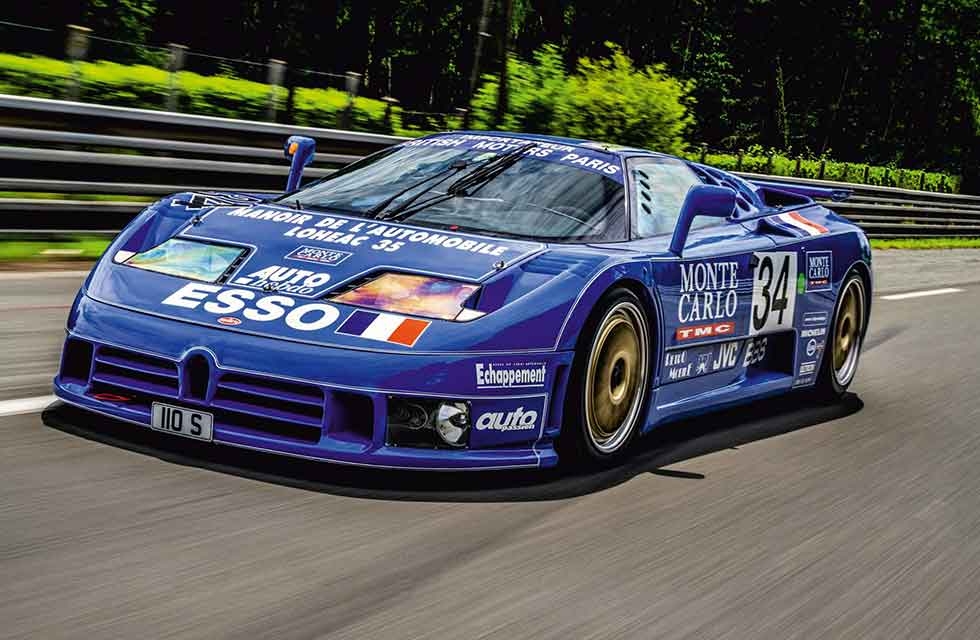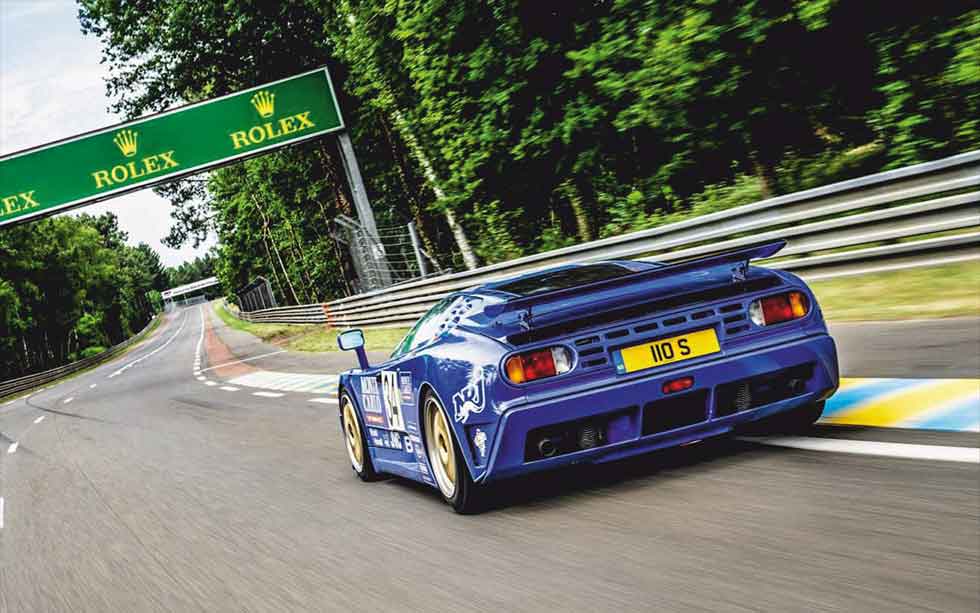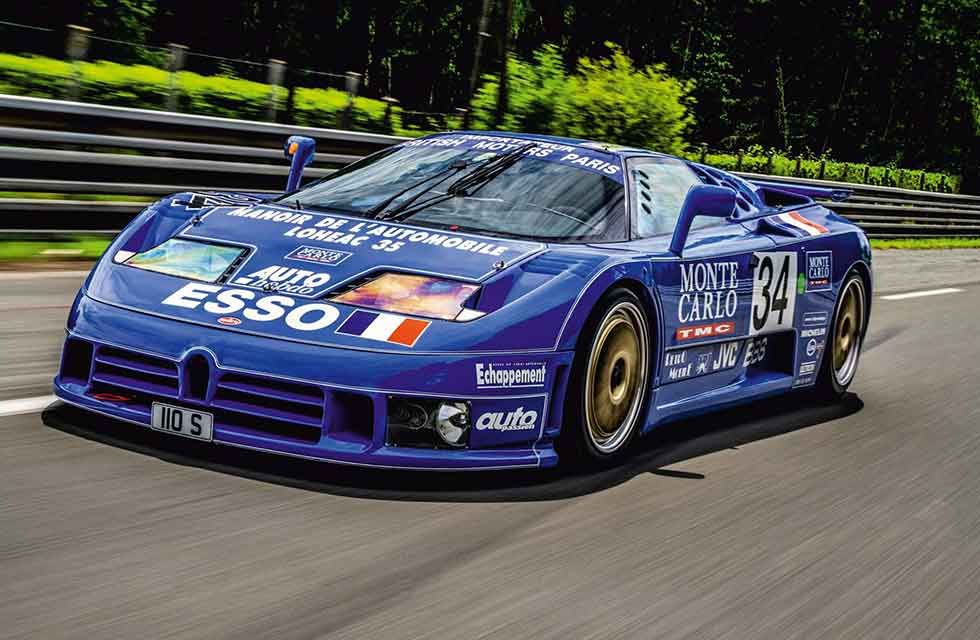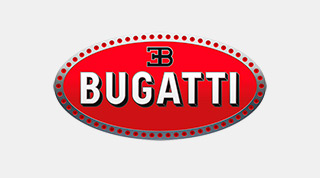
Le Mans Bugatti EB110. Taking the ’1994 Le Mans car back after 25 years. Plus, meet its spiritual successor, the Centodieci. The very last Bugatti to race at Le Mans returns for the first time ever to the Circuit de la Sarthe. Words Dale Drinnon. Photography Rémi Dargegen.
A dream out of time Bugatti EB110 LM
Forget about the viral in-car videos. Throw the computer games in the rubbish bin. Nothing really prepares anyone for this. The rush up the long hill from the grid, with 600bhp jammed against my back and the turbos whooshing; barely kissing the dragon’s teeth lining the right-hander and flicking across to the left-hand set, far tighter than I’d ever imagined, hard right again and the Dunlop Bridge zooming ever closer. I don’t really see it, mind; the Bridge itself is irrelevant. What dominates my attention is the totally blind crest and the lightness welling up as I swoop down the other side.

The lightness in my belly, too, not so much from the swoop as from the fact I’m driving the very last Bugatti to race in the Le Mans 24 Hours, on its first return to the Le Mans circuit and the exact 25th anniversary of its 1994 start. That the date misses this year’s actual running just enough to put us on track with the clean-up crews, and that my sneaky bootleg charge through the Dunlop Chicane is the palest imitation of real racing, are but a sad reflection of the entire EB110 story, road or race. It was an outrageous, upstart, 200mph dream, out of step and out of time, a Don Quixote tale doomed to failure not entirely of its own making.
‘AN EARLY FUEL TANK LEAK WAS STEMMED WITH A MAJOR SLAP OF QUICK-SET EPOXY’
The highlights of the Bugatti EB110 saga are now legend. Romano Artioli, prosperous Italian businessman, auto entrepreneur and rabid Bugatti enthusiast, decides in the late 1980s to fulfil a lifelong ambition and revive the brand. In accordance with the principles laid down by Ettore Bugatti himself, the new Bugatti will be the world’s finest, built from the finest materials in the finest factory. It will be the fastest, the most exclusive, a true Bugatti in every sense. It will have the highest technology, too: full-time four-wheel drive, a carbon chassis that beat McLaren to the punch, and not one, nor two, but four turbochargers on its V12 engine.

On its debut in September 1991, on Ettore’s 110th birthday, the launch would also be the finest. Held in Paris in tribute to the grand marque’s historic origins (and doubtless the ample French resources that went into the rebirth), the festivities include a French Racing Blue EB110 paraded through the heart of the city, around the Arc de Triomphe and on to a massive Versailles soirée a thousand champagne bottles deep. With prescient branding instincts, the revival was accompanied – preceded, actually – by boutiques of Bugatti lifestyle accessories, from designer scarves to a bespoke EB110 fountain pen. One of which I’d love to have, by the way, if anyone is feeling generous.
But here’s the thing. Artioli really did come through on those superlatives. The launch event attracted gentry from across the world, and the factory in Italy was as far from a dark satanic mill as could be imagined. It was a welcoming, airy space, glorious with natural light, a flood of cutting-edge tooling and equipment, much expensive tiling and a warm, inviting staff café where everyone dined together, from wash-bay guys to Romano and visiting CEOs. And the car?
The car was damn near magical. Say what you will about its styling – and opinions have run the gamut – no one who has driven an EB110 can honestly fault its qualities as an automobile. Never mind the car’s various top speed records; in the real world that’s as meaningless as counting angels atop a pinhead. What matter are road manners, chassis dynamics and usable power, and there the 110 was supreme. The four-wheel drive and excellent balance kept this megahorse hypercar consistently planted and poised, allowing the driver access to every one of those horses whatever the circumstances, all without traction or stability controls. As a complete performance package, the re-born Bugatti was simply dazzling.
Inevitably, then, somebody would have the idea to take it racing. Credit for that belongs to none other than the man behind Artioli’s remarkable factory: his cousin, architect Giampaolo Benedini. Benedini also contributed the final shape of the 110, after contracted designer Marcello Gandini’s submission left Artioli, shall we say, less than impressed. As a key participant in the total project, and a keen club racer, Benedini was sure motorsport could be an important factor in the venture’s long-term success. From 1993, he and Artioli were exploring ways and means of restoring the Bugatti name to competition.
A good deal of the pathway led directly from the ensuing EB110 SS, the lighter, more powerful Supersport evolution in development well before serious thought was given to a racing programme. Michael Schumacher famously owned a screaming yellow one, bought with his own money – theoretically, at least. By late 1993, however, the Le Mans attempt was green-lighted with technical development handled through the factory R&D department and the cream of Italy’s supercar brain trust. The racing conversion was by French track-prep specialists Synergie Automobile and Meca Système, while team organisation went to French magazine publisher, ex-racing driver and official race entrant Michel Hommell, also a team sponsor.
Imbued with astounding optimism, the team aimed for the 1994 race to commemorate the 55th anniversary of Bugatti’s last Le Mans win by Wimille and Veyron in 1939 with the Type 57 ‘Tank’ (Bugatti people are evidently gaga for anniversaries). Somehow they made it, despite tremendous 4WD weight problems and the perennial difficulties faced when stretching even advanced road parts way beyond design specs. Milking the publicity cow to the last drop, they furthermore drove the single, one and only race car down to Le Mans (there’s that optimism again) from central Paris, on public roads.
We, however, are not doing that. After all, we lack both the police escorts of ’94 and any hint of radiator fans, and French speed bumps appear to have multiplied exponentially in the intervening period. But we do officially kick off our adventure from the lovely old Hotel de France in nearby La Chartre-sur-le-Loir, a traditional hostelry and watering hole for Le Mans racers since the age of Bugatti s Type 57. Then we re-load that single, precious, irreplaceable race car on the trailer and go to the circuit.
The track is immersed in bedlam nearly as comprehensive as that of the preceding race weekend. Yet more Le Mans trivia: the famed eight-ish mile ‘Sarthe’ circuit, in use since 1923, exists solely for the annual 24 Hours and the every- other-year Le Mans Classic. In between it’s largely ordinary commuter roads, linkable to a smaller permanent venue called, with rather poetic justice, le Circuit Bugatti. This incorporates the hallowed pit straight and the most recognisable landmark in sports-car racing, the Dunlop Bridge. Following every 24 Hours, however, is the Herculean task of de-coupling the circuits Sarthe and Bugatti, and removing the chaos of what a week ago had been an impromptu city of vagabonds.
It’s near the Bridge that we de-trailer, intending to grab, discreetly, a nice batch of posed bridge-in-background static images and be satisfied. But it gradually becomes clear that of all the territory inside the Bugatti Circuit, nothing is less crowded and gives a better action photo opportunity than the awesome sweep from pit-out to Dunlop Bridge. This seems too good to be true, so I take a recce with the owner’s designated driver. Then it’s move over and gimme that damn steering wheel, dude.
Please note that while I know this car, having attended the handover from previous owner to current one several years ago, I’ve never driven it before. Adding to the apprehension is that the layout is considerably different from either standard or the Le Mans test mule EB110 with which I once had a fabulous day. The fixed driver’s position, perfect in the steering reach, is a touch long in the legs with the harness attached, and after about a half-second of deliberation I decide better the pedals than the belts. With some coaching on the French-labelled switches (shamefully, my French consists by and large of wine and food practicalities), I manage to spin the starter.
I’ll spare you, this once, the delights of cough and fire and the opening song of V12 race engine; suffice to say that the sexual allusions would embarrass both of us. That aside, and allowing for the absence of any sound-deadening interior comforts and the sound-shredding effect of the turbos, it doesn’t seem significantly louder than a 110 SS road car. The six-speed shifter is just where it should be, the pedals are perfectly spaced and ideal for heel-and-toe even, though I’m wearing my favourite old leather derbies, not driving boots.
Outward visibility, as well as driver ingress/egress, loses much to the roll cage, but at least we have the outside mirrors which still adjust electrically. The inside mirror is mainly useless, with that barn-door wing stuck out behind.
Thankfully, the full-width windscreen crack doesn’t distract to any great extent; screen cracks are reportedly a repeating problem and the car doesn’t race any more, so the owner usually ignores them. Interior fit and finish are what you expect in a racer completed in a rush of workshop all-nighters against a manic deadline.
All the control efforts and feedbacks – steering, clutch, gearchange – feel identical to a regular 110’s. There’s a slight tendency to fluff after extended low-rev running, or at tickover, requiring an occasional throttle blip, and what a dreadful inconvenience it is to gratuitously zap that lovely engine. On the slow trundle down to the pit straight from our rally point across the Dunlop hill, I’m already at home with the car to a degree I wouldn’t have anticipated.
Given a turning circle barely smaller than that of the truck that carried it here, swinging around to run the Bridge complex is the hardest part of driving the thing. Otherwise it’s as friendly as any modern sports car and, in truth, friendlier than some. And with a real gearbox and clutch, it’s far more fun. It’s easy to see how an ordinary driver like me could get in over their head, though, so after another go just for bragging rights – ‘Yeah, that’s interesting, but let me tell you what I did recently in France’ – we leave the permanent circuit for the open highway sections, somewhat concerned that pitchforks and flaming torches might arrive if we don’t. Oddly enough, those prove more conducive to fun than the enclosed track. Normal traffic routing has already been restored; the chicanes on the Mulsanne Straight, for instance, are now bypassed, and cars use the ordinary roundabout at the straight’s end instead of the race-days-only special right-hander leading from Mulsanne over toward Indianapolis. After rush hour the flow has also thinned down tremendously. With some prudence and an eye on outright speeds it’s possible, if not to let the beast run free, to allow some slack in the leash, anyway.
The results are shockingly… unshocking. Full-bore launches off the line would have to be insanely hard to really break the tyres loose, and might not be possible at all. The four-wheel drive simply hooks up and goes, and there’s no raucous, look-at-me exhaust thunder like some current street exotics (ahem, Prancing Horse). It’s as though the essential character of how Artioli thought a latter-day Bugatti should be was carried on into the racing version: a blindingly quick and competent car for mature grown-ups, not concerned with impressing the onlookers. Two decades later, I think EB110 owners haven’t changed; they tend to keep their cars on the down-low, and many don’t especially care for public recognition, either.
Blindingly quick also hasn’t changed. A production EB110 SS was good for some 220mph and got to 60mph in about three seconds, numbers still due proper respect against today’s techno wondercars. The Le Mans racer has the same 600bhp, the maximum allowed under the 1994 regulations, and weighs far less, likely almost 200kg less. Admittedly, it’s a seat of the pants judgment, but it feels every bit as fast as the aforementioned test mule, which claimed an extra hundred horsepower. Blasting down the Mulsanne in full racing conditions, it must have seemed like the Millennium Falcon going light-speed.
And tragically, the Mulsanne was where, to use a hackneyed but apt metaphor, the wheels came off the Bugatti dream. Le Mans 1994 was supposed to be a return to the event’s lost traditions of production-based machinery, after a period of increasingly frenzied prototypes. Porsche, however, working through its Dauer surrogate, converted the highly developed Porsche 962 proto into the Dauer 962 production GT, then back, to meet the letter of the regs, into a Dauer 962 production racer. None of the genuine street-based entries thereafter had a chance. Nonetheless, the debutante Bugatti qualified 17th. In the race, despite an early fuel tank leak stemmed by entrant and seasoned racer Hommell with a major slap of quick-set epoxy, plus multiple turbo-replacement stops, the 110 recovered strongly under French drivers Alain Cudini, Éric Hélary and Jules Boullion. It was heading for a likely top-five finish with 45 minutes to go when, as Boullion was overtaking a Dodge Viper, the Bugatti jinked left in the braking zone at the fast end of Mulsanne, hammering the Armco.
Whether it was tyre failure, brake failure, suspension collapse or driver error is unresolved to this day, but the result was indisputable: a big, fat Bugatti DNF.
In reality, it was the least of Bugatti’s troubles. Sales had lagged, a combination of production delays and world economic recession. The financials were always shaky, for reasons long debated and darkly rumoured, but it’s now certain that Artioli had bet his veritable shirt on it. The company folded in September 1995; Artioli sold the naming rights to VW three years later, making way for one more chapter in the continuing Bugatti legend.
As for Romano Artioli, he moved on, looking steadfastly towards the future as people of his remarkable calibre always seem to do. When we last met a couple of years ago, he was engaged in a new sustainable energy project with his family engineering concern. Courteous, generous and charming as ever, and in his mid-80s, he insisted on personally fetching the chairs and drinks with which we, his guests, enjoyed the view outside his villa above the Mediterranean. We talked for ages, and he made it feel like minutes. He also knew intimately the best ice cream joint in town.
Likewise, Giampaolo Benedini has hardly skipped a beat. It’s true that his once-magnificent Bugatti factory now lies empty and overgrown, and it is a truly heartbreaking thing to visit, a lonely monument to noble ambitions struck low. But his architecture and design firm is successful in everything from industrial construction to home furniture and he, too, still exudes the family’s trademark warmth and good humour. He resides in his ancestral home town of Mantua, and is passionately involved in two of its most treasured institutions – the museum of Mantua’s favourite son, the legendary racer Tazio Nuvolari, and the Italian National Fire-Fighter’s Museum.
But what of the car? After its singular racing experience, the Bugatti EB110 Le Mans went immediately with Michel Hommell to his own automotive museum, le Manoir de l’Automobile in Brittany. There it was sympathetically repaired and displayed in the midst of the finest collection of the finest historic French racing and classic cars to be found anywhere. I had my first glimpse of it there in 2011, quite coincidentally, while savouring the delights of elegant Facel Vegas, Art Deco Peugeots and long-tail enduro Alpines. Considerably later, I was along when Hommell and Current Owner took it for a hand-over thrash around Hommell’s racing circuit out back.
Current Owner, however, is one of those who doesn’t especially care for public recognition and tends to keep his cars on the down-low. So that’s what I’ll do. It’s enough that 25 years on, a Bugatti has once more appeared at Le Mans. If it was a quixotic gesture, then or now, but a little more of Don Quixote might be exactly what this world needs.
Above Drinnon finds the cabin little noisier than the roadgoing Supersport’s, despite lack of soundproofing and trim. Fixed driving position means he can’t wear belts and operate pedals simultaneously. Clockwise from top left It’s hard to believe this thunderous EB110 was driven from Paris to Le Mans on public roads in 1994 – 25 years later it is being driven on the circuit for the first time since; engine is more or less standard Supersport but still has 600bhp; cabin is as stripped-out as it can be, the work clearly done in haste.
Bugatti EB110 Le Mans
Engine 3499cc mid-mounted DOHC four-turbo V12, five valves per cylinder
Max Power 600bhp @ 6200rpm
Max Torque 513lb ft @ 5000rpm
Transmission Six-speed manual, four-wheel drive
Suspension Front and rear: double wishbones, coil springs, anti-roll bar, telescopic dampers
Brakes Ventilated carbon-ceramic discs, ABS
Steering Rack and pinion
Weight c1220kg
Top speed 220mph
0-60mph 3.1 sec
BUGATTI CENTODIECI
ON THE SHOULDERS OF A GIANT
Stunning new Centodieci takes inpiration from the EB110 Super Sports. Words James Elliott.
The launch of any Bugatti is a major event. After all, it isn’t very often that a whole new model comes along – about once a decade since the company’s rebirth under the visionary Romano Artioli, in fact.

That goes some way to explaining the massive blast of publicity accorded to the new Centodieci. The CIA-rivalling secrecy surrounding the car until it broke cover recently during Monterey Car Week just added to the mystique and drama. So when the new car was unveiled, awash in visual cues from the EB110, it ramped up the hype even more – especially with all those pictures of it posing with our feature car and others.
Bugatti openly admits that the Centodieci’s inspiration was the EB110; heck, even the name translates from Italian as ‘110’. Stephan Winkelmann, president of Bugatti, said: ‘With the Centodieci we pay homage to the EB110 Super Sports car, which was built in the 1990s and is very much a part of our tradition-steeped history. With the EB110, Bugatti catapulted itself to the top of the automotive world once again after 1956 with a new model.’
Bugatti’s head designer Achim Anscheidt added: ‘We faced a number of technical challenges in terms of the development and design of the Centodieci. The EB110 is a very flat, wedge-shaped and graphically quasi-two-dimensional super sports car of the late 1980s. Transporting this classic look into the new millennium without copying it was technically complex, to say the least.’
Mechanically, there is one huge difference between the EB110 and its heir – instead of a V12 powerplant, the Centodieci is powered by the 8-litre W16 that develops 1600bhp at 7000rpm. That means the Centodieci can sprint from nought to 100km/h in 2.4 seconds and the top speed is electronically limited to 380km/h (235.6mph).
But the real acid test is what Artioli thinks of it. Before seeing the Centodieci, he certainly welcomed the concept of a ‘tribute’ car: ‘I read the rumours about a new Bugatti being presented at Pebble Beach and it being inspired by the EB110… it would mean a lot to me, to my whole family, and to my old companions at Bugatti Automobili.
‘The EB110 SS was designed to last for a long time, into the future, and for this reason all the technical solutions that had been anticipated are present today in the new Bugatti cars. I would be very pleased if even the design of the possible future Bugatti was inspired by the EB110 SS, which is still contemporary. The EB110 was a car ahead of its time, 110% worthy of carrying the name Bugatti. I might not be the most impartial person in this matter, but no other car deserves a tribute more than the EB110.’






